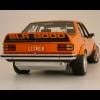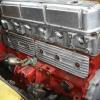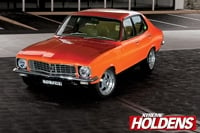Lightened flywheel on stock 173
#1
 _73LJWhiteSL_
_73LJWhiteSL_
Posted 02 September 2006 - 02:38 PM
a mate has offered me a lightened flywheel to stick behind the 173, just a question, is there any point sticking this behind a stock 173 running GRA carb and extractors with 2" exhaust?
I think its a waste of time with a stock motor, but what do others think?
thanks
Steve
#2

Posted 02 September 2006 - 05:34 PM
Heavy flywheels are about momentum, e.g. more pull up a hill.
I would think a lightened flywheel would need more throttle opening to idle especially with a bigger cam.
Your call.
#3

Posted 02 September 2006 - 05:46 PM
#4

Posted 02 September 2006 - 06:10 PM
#5
 _CHOPPER_
_CHOPPER_
Posted 02 September 2006 - 06:13 PM
#6

Posted 02 September 2006 - 06:25 PM
#7
 _73LJWhiteSL_
_73LJWhiteSL_
Posted 02 September 2006 - 07:08 PM
Thanks for the thoughts guys... I think I will give it a miss.
Steve
#8

Posted 02 September 2006 - 09:29 PM
I wouldn't bother again.
#9
 _devilsadvocate_
_devilsadvocate_
Posted 02 September 2006 - 10:50 PM
The mass is especially important for smooth take offs in manual cars and would cause considerable clutch problems otherwise.
Re, the car deacclerating more quickly up hills without flywheels. Ive never driven underpowered cars without flywheels but looking at the numbers it seems unlikely that this is a significant effect. One only has to rev the motor of a car and take their foot of the accelerator to know that the revs drop down to idle in a fraction of a second. If the motor drops speed this quickly with only the load of compression on it, its not going to be able to store enough energy to make any significant differnence to how far/fast a car goes up a hill, there is simply not enough mass in the flywheel to achieve this. An engine spinning at 3000rpm with a 20kg flywheel would have the about the same stored energy as that of a cyclist doing 50kmh. In fact the four wheels of the car will offer more when travelling at 100kmh.
Of course there is also the rotational momentum stored in the all the other rotating parts of the engine and drivetrain, but we are looking at the "extra" propulsion supplied by the flywheel itself.
Edited by devilsadvocate, 02 September 2006 - 11:03 PM.
#10

Posted 02 September 2006 - 11:33 PM
#11
 _devilsadvocate_
_devilsadvocate_
Posted 03 September 2006 - 01:11 AM
This is not quite correct, with a flywheel the torque output of the engine will be simply averaged between times of max torque.......piston powerstroke and -ve torques, compressions stroke(torques applied in opposite direction).The big downside to a lighter flywheel is that torque is reduced � most noticeably on a hill.
At high revs this should make no difference in the cars ability to climb a hill, at very very low revs(less than idle speed) it may indeed make some difference, a bit like not being able to step on the pedal of a bicycle when you want to take off.
Edited by devilsadvocate, 03 September 2006 - 01:20 AM.
#12

Posted 03 September 2006 - 08:38 AM
Yeah, a heavy flywheel will aid an engine especially under strain primarily at low revs. It doesn't really matter whether you're going up a hill or not, I think that statement is just because when the engine is at relatively low revs and under some strain, you generally are climbing a hill.at very very low revs(less than idle speed) it may indeed make some difference
The reason a circuit car would have less need for it, is because the engine is all designed to run smoothly at high revs (timing, cam etc) and if the engine is running smoothly at its own accord, there is no need for a particularly heavy flywheel behind it. And the obvious fact that when anything matters in a circuit car, it is gonna be at high revs, and I can't say I've driven a full race car, but I can imagine they would be a pig to cruise around in at low rpm.
Edited by Heath, 03 September 2006 - 08:39 AM.
#13

Posted 03 September 2006 - 09:24 PM
One bike is made to produce power at high revs, the other is for plodding around often at very low revs without stalling.
Hope this helps.
#14

Posted 03 September 2006 - 09:32 PM
#15

Posted 03 September 2006 - 09:51 PM
I mean putting a heavier flywheel on a motor can't really boost its power output, but if a motor with a light flywheel is almost stalling at maximum compression, and then it puts all of its power into just getting it spinning quickly again each rev (assuming it has lost a lot of its momentum), and then you install a heavier flywheel which lets it run really smoothly at the same RPM (no slowing down and then speeding up), then I imagine it would be producing substancially more torque; because the internals are not losing much innertia...
Would that be agreeable?
#16
 _devilsadvocate_
_devilsadvocate_
Posted 03 September 2006 - 10:20 PM
So yes.....if no flywheel and if motor is spinning very slowly the motor could easily get bogged down if max torque was needed when on different parts of the cycle.with a flywheel the torque output of the engine will be simply averaged between times of max torque.......piston powerstroke and -ve torques, compressions stroke(torques applied in opposite direction)
You are sort of right Heath, without the flywheel the engine may struggle to complete one revolution at low rpm, though I believe it will still get there, but it will be a lumpier ride, however, your idea is for a single piston engine. Engines with even no. of cylinders always have one piston on the compression stroke while another is on the power stroke, the compressions wont be capable of killing the engine, so the flat spots in torque will be between firings. Odd no cylinder engines dont thave these going on in pairs so there can be even flatter spots in between power strokes.
small point: an object's inertia is independent of its speed, momentum is dependent on speed
Edited by devilsadvocate, 03 September 2006 - 10:35 PM.
#17

Posted 04 September 2006 - 01:16 AM
question?
if there are two people pushing a barrel each along the road at the same speed but one barrel weighed 25kg and the other weighed 50kg, and you had to stop them, which one would take longer to stop?
#18
 _devilsadvocate_
_devilsadvocate_
Posted 04 September 2006 - 02:51 AM
Yes, the crankshaft is counter balanced etc, so that when it is spun quickly there will be no vibration problems. It cant be counter balanced to offset the uneven forces of the power stroke though, otherwise the engine would vibrate horribly when in engine overrun mode where the force of the powerstroke is at its minimum, or even absent completely in newer cars where the fuel is shutdown on overun.i dont think the flywheel has a direct relation to smoothness of idle etc as the crankshaft is counterballanced and its momentum would be enough to overcome any resistance of compression, the weight of the flywheel is more related to the application of the motor.
The momentum of the crankshaft is simply not enough to make it turn smoothly at low rpm when the power stroke and compression stroke are acting upon it. This could be achieved by increasing the rotational inertia of the crank itself(making the crank much more massive). However, to keep the weight of the total engine/flywheel combination to a minimum, the necessary rotational inertia can be achieved with less mass by using a flywheel where the rotating mass can be placed at a greater distance from the axis of the crankshaft.
Possibly exactly the same engine in a truck would use a heavier flywheel as low speed smoothness is more important than quick changes in rpm and given the overall mass of the truck say a 5kg increase in mass is not that important. As you say the application will dictate the best mass of the flywheel, Id guess the "same engine" fitted to a truck would also come with a cam more suited to lower rpm work as well.
Edited by devilsadvocate, 04 September 2006 - 02:54 AM.
#19

Posted 04 September 2006 - 01:53 PM
#20
 _82911_
_82911_
Posted 16 September 2006 - 05:53 PM
On the subject of real world , not theory..........
low rev max pulling power eg: Diesel trucks.... they also have very heavy crankshafts that can also help with the rotational inertia side of things...
For all out revs and max race applications....
A heavy flywheel weight will not really hinder the accelration rate of a race car....
This is because the car leaves the line with a lot of revs already on board so it doesn't need to build up the momentum to store on the flywheel, it is already there because of the higher revs....
Where a light flywheel is a MAJOR ADVANTAGE is helping the engine to loose revs quickly, like when breaking hard or during a gearchange. This is the major reason that we use really light flywheels and very small diametre clutches in circuit racing.
The quicker an engine can drop revs on a gearchange, the quicker the driver can get the next gear, either up or down it doesn't matter....
As a matter of interest my 202's loose revs so quickly on a gear change that it is a bit of a task to avoid crunching gears as thew revs drop so quick that the synchro cone hasn't yet had time to slow the spinning gear, so sometimes it crunches.. mainly 3-4 change going up... You don't get this however on a full dogbox.... so the quicker you can loose revs the quicker you get the next gear and start accelerating again....
That's the only reason why light flywheels are used in cicuit racing......
As for the road..... well a slightly heavier flywheel will store a bit more momentum for the climb from idle to say 2500rpm@ which point te gain is one of diminishing proportions....
In a "STREET" car i always use a standard weight flywheel.... helps to save on some clutch slipping on take off as well.. especially if the cam a touch bigger than say 30/70 or 235@ 50
Cheers greg..
0 user(s) are reading this topic
0 members, 0 guests, 0 anonymous users







 View Garage
View Garage











